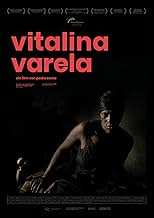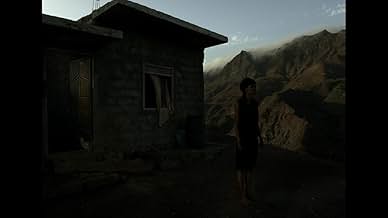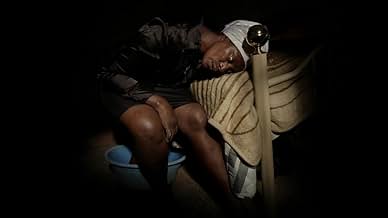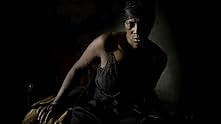AVALIAÇÃO DA IMDb
6,7/10
2,6 mil
SUA AVALIAÇÃO
Uma mulher cabo-verdiana navega por Lisboa, seguindo os poucos traços físicos deixados pelo falecido marido e descobrindo sua vida secreta e ilegal.Uma mulher cabo-verdiana navega por Lisboa, seguindo os poucos traços físicos deixados pelo falecido marido e descobrindo sua vida secreta e ilegal.Uma mulher cabo-verdiana navega por Lisboa, seguindo os poucos traços físicos deixados pelo falecido marido e descobrindo sua vida secreta e ilegal.
- Direção
- Roteiristas
- Artistas
- Prêmios
- 24 vitórias e 29 indicações no total
- Direção
- Roteiristas
- Elenco e equipe completos
- Produção, bilheteria e muito mais no IMDbPro
Avaliações em destaque
Superb use of sound and camera, fascinating performances. My first Pedro Costa film--what a joy to view it. Reminded of Sokurov's "Mother and Son"--had he made it, it would be probably titled "Wife and Husband." This Pedro Costa film is definitely one of my best 2019 films. Winner of Golden Leopard and the Best Actress awards at Locarno film festival. Well deserved!
The islands of Cabo Verde (Cape Verde), in the Atlantic, 600 km west of the Senegal coast were a Portuguese colony until 1975. As a country, they enjoy the dubious distinction of having more of its citizens living abroad (700,000) than at home (560,000), which reflects the lack of job opportunities. In particular, about 100,000 live in Portugal, most of them eking out a living out of low paying jobs.
The scenario is Cova da Moura, a suburb of Lisbon, whose inhabitants are 75% from Cape Verde. Its houses were constructed by the locals, without the benefit of a permit. It is an urban island without open spaces, with streets of random widths and serious crime problems,
The main character is Vitalina Varela (played by herself), Her husband Joaquim left her (and his homeland) 25 years ago in search of better opportunities. He settled in Cova da Moura, where he built a precarious house, with insufficient light, crumbling walls, leaking roof and untiled floor (he and Vitalina had constructed a cheerful, airy house back home). Vitalina hears no more of him until she is informed that Joaquim has taken ill. She flies to Lisbon but arrives three days after the funeral. She learns about Joaquim's life from various dwellers of the shantytown. She also reconnects with a priest that she knew from the islands.
This is it. Director Pedro Costa tells the tale in a rather peculiar way. The pace is slow, sometimes excruciatingly so. Every shot by cinematographer Leonardo Simões is carefully composed; the lighting is unabashedly artificial and produces chiaroscuro scenes that, of course, remind one of Caravaggio. Crumbling cement walls, squalid interiors and unpaved lanes take a three dimensional quality and a life of their own. We don't see the shantytown as the locals see it but through the eye of a painter. We all "know" that excessively elaborate cinematography may interfere with the tale being told, but the director stands this rule on end. The final result is worth watching, even if only for the visuals.
The scenario is Cova da Moura, a suburb of Lisbon, whose inhabitants are 75% from Cape Verde. Its houses were constructed by the locals, without the benefit of a permit. It is an urban island without open spaces, with streets of random widths and serious crime problems,
The main character is Vitalina Varela (played by herself), Her husband Joaquim left her (and his homeland) 25 years ago in search of better opportunities. He settled in Cova da Moura, where he built a precarious house, with insufficient light, crumbling walls, leaking roof and untiled floor (he and Vitalina had constructed a cheerful, airy house back home). Vitalina hears no more of him until she is informed that Joaquim has taken ill. She flies to Lisbon but arrives three days after the funeral. She learns about Joaquim's life from various dwellers of the shantytown. She also reconnects with a priest that she knew from the islands.
This is it. Director Pedro Costa tells the tale in a rather peculiar way. The pace is slow, sometimes excruciatingly so. Every shot by cinematographer Leonardo Simões is carefully composed; the lighting is unabashedly artificial and produces chiaroscuro scenes that, of course, remind one of Caravaggio. Crumbling cement walls, squalid interiors and unpaved lanes take a three dimensional quality and a life of their own. We don't see the shantytown as the locals see it but through the eye of a painter. We all "know" that excessively elaborate cinematography may interfere with the tale being told, but the director stands this rule on end. The final result is worth watching, even if only for the visuals.
An expressionistic melancholy spell. Painstakingly composed and beautifully lit. The texture and hues of the images are remarkable.
The images do very little of the storytelling beyond place, space, and tone. The story itself is almost completely orally told. Even then, words emerge after long ambient soundscapes of unseen "slum life" always just happening beyond the image's frames or on the other side of walls.
Whether it's day or night, it's almost always pitch, with pinpoint spotlighting illuminating only parts of this desolate world and the striking faces that occupy it. Most of the image is in consummate shadow. Until the end, when, finally, emerging from out of our mourning, we begin to see daylight and sky. Most of this sky is in memory, but not all.
The pacing is so languid and the creative choices so deliberate that we have plenty of time to live inside the images and moments.
I felt there was some Bergman here: the disenchanted priest; the memory haunted spaces and characters; the faces floating in darkness, only their eyes revealing the depths of their emotional experiences.
You are forgiven for thinking that this film is boring or could be shorter. You are forgiven for thinking that it is perfect as it is, even somehow fragile; that it creates the exact effect on the viewer that is intended.
You are forgiven for thinking and feeling anything you've ever thought and felt, as long as you turn your face towards kindness from this moment forward... but you must do it quick, before the credits roll.
The images do very little of the storytelling beyond place, space, and tone. The story itself is almost completely orally told. Even then, words emerge after long ambient soundscapes of unseen "slum life" always just happening beyond the image's frames or on the other side of walls.
Whether it's day or night, it's almost always pitch, with pinpoint spotlighting illuminating only parts of this desolate world and the striking faces that occupy it. Most of the image is in consummate shadow. Until the end, when, finally, emerging from out of our mourning, we begin to see daylight and sky. Most of this sky is in memory, but not all.
The pacing is so languid and the creative choices so deliberate that we have plenty of time to live inside the images and moments.
I felt there was some Bergman here: the disenchanted priest; the memory haunted spaces and characters; the faces floating in darkness, only their eyes revealing the depths of their emotional experiences.
You are forgiven for thinking that this film is boring or could be shorter. You are forgiven for thinking that it is perfect as it is, even somehow fragile; that it creates the exact effect on the viewer that is intended.
You are forgiven for thinking and feeling anything you've ever thought and felt, as long as you turn your face towards kindness from this moment forward... but you must do it quick, before the credits roll.
In this movie Vitalina Varela performs her own person role in an event of her personal life as a non-professional actress.
As a Capeverdian living in Cape Verde (a former Portuguese colony) she saw her husband leaving to work in Lisbon, Portugal. Only 25 years later she managed herself to leave to Portugal to join her husband. However she arrived there three days after his death. Then an atmosphere of sorrow and bitterness sets itself in the movie even suggested by the image darkness, the slow movement of characters and their foreground plan faces. Meanwhile Vitalina becomes aware that her husband's behaviour was rather illicit.
A remarkable movie direction by Pedro Costa.
As a Capeverdian living in Cape Verde (a former Portuguese colony) she saw her husband leaving to work in Lisbon, Portugal. Only 25 years later she managed herself to leave to Portugal to join her husband. However she arrived there three days after his death. Then an atmosphere of sorrow and bitterness sets itself in the movie even suggested by the image darkness, the slow movement of characters and their foreground plan faces. Meanwhile Vitalina becomes aware that her husband's behaviour was rather illicit.
A remarkable movie direction by Pedro Costa.
A poignant story in an extraordinary setting, shown in a poetic, serene way.
Gorgeous cinematography, shot in a clair-obscur style which highlights certain distinct colours from the darkness (at times reminiscent of old masters's paintings, such as the work of Caravaggio or Rembrandt).
Strong, pure acting by the lead actors - Vitalina Varela and Ventura.
Pedro Costa tells his story slowly, but intelligently. Instead of presenting the plot outline on a silver platter, he challenges the viewer to discover this for himself. Costa's style of story-telling reminds me of Bela Tarr's films; both prefer the visual language over the spoken one.
This film is not very accessible, and requires full attention. But it will prove to be very rewarding in the end.
Gorgeous cinematography, shot in a clair-obscur style which highlights certain distinct colours from the darkness (at times reminiscent of old masters's paintings, such as the work of Caravaggio or Rembrandt).
Strong, pure acting by the lead actors - Vitalina Varela and Ventura.
Pedro Costa tells his story slowly, but intelligently. Instead of presenting the plot outline on a silver platter, he challenges the viewer to discover this for himself. Costa's style of story-telling reminds me of Bela Tarr's films; both prefer the visual language over the spoken one.
This film is not very accessible, and requires full attention. But it will prove to be very rewarding in the end.
Você sabia?
- CuriosidadesOfficial submission of Portugal for the 'Best International Feature Film' category of the 93rd Academy Awards in 2021.
- ConexõesSpin-off from Cavalo Dinheiro (2014)
Principais escolhas
Faça login para avaliar e ver a lista de recomendações personalizadas
- How long is Vitalina Varela?Fornecido pela Alexa
Detalhes
Bilheteria
- Faturamento bruto nos EUA e Canadá
- US$ 14.941
- Fim de semana de estreia nos EUA e Canadá
- US$ 4.612
- 23 de fev. de 2020
- Faturamento bruto mundial
- US$ 56.860
- Tempo de duração
- 2 h 4 min(124 min)
- Cor
- Proporção
- 1.33 : 1
Contribua para esta página
Sugerir uma alteração ou adicionar conteúdo ausente




















